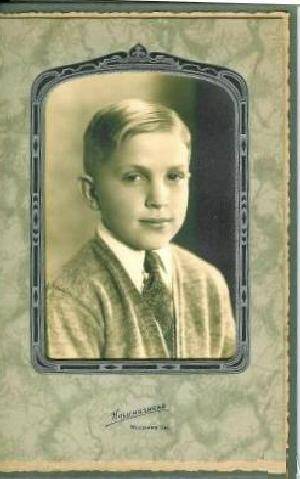
Photographs: Print Cards and Paper Frames--1930s

Figure 1.-- We note stand-up frames in the 1930s. We think most portraits came in stand up frames. We are not yet sure about the color and decoration. We note one portrait measuring 3 1/2" by 5". It is in a studio cardboard folder and frame that measures 4 3/4" by 7 1/2". The frame is printed on the lower right corner "Hollingshead Woodland, Cal." At the bottom of the cardboard frame is the fold-back flap to make it stand up. On that written in ink is "John Louis Sanstrum April 1935". Notice the decorated blue border around the actual portrait and the motteled coloring around it.
|
|
We note stand-up frames in the 1930s. We think many portraits came in stand up frames. We are not yet sure about the prevalence. We are not yet sure about the color and decoration. We believe these stand-up frames first appeared in the 1920s, but we are not yet positive. This needs to be confirmed. They were clearly common in the 1930s. We note plain flat paper frames. We are not entirely sure about the decoration on these frames, but Art Deco was still used. We think that portraits still came with flaps, but our archive of these portraits is still limited.
We note stand-up frames in the 1930s. We think many portraits came in stand up frames. We are not yet sure about the prevalence. We are not yet sure about the color and decoration. We believe these stand-up frames first appeared in the 1920s, but we are not yet positive. This needs to be confirmed. They were clearly common in the 1930s. The stand-up frames of course were made without flaps.We note one portrait measuring 3 1/2" by 5". It is in a studio cardboard folder and frame that measures 4 3/4" by 7 1/2". The frame is printed on the lower right corner "Hollingshead Woodland, Cal." At the bottom of the cardboard frame is the fold-back flap to make it stand up. On that written in ink is "John Louis Sanstrum April 1935". The photo measures 3 1/2" by 5". It is in a studio cardboard folder and frame that measures 4 3/4" by 7 1/2". The photo is printed on the lower right corner "Hollingshead Woodland, Cal." At the bottom of the cardboard frame is the fold-back flap to make it stand up. On that written in ink is "John Louis Sanstrum April 1935".
Another good example is an unidentified American family.
We note plain flat paper frames. We do not know how common this format was. We are also not entirely sure about the decoration on these frames, but Art Deco was still used. A good example is a portrait of a band boy in 1930. The frame is grey-brown or light brown with blue highlights in the Art Deco styling. There were faux corners.
We think that portraits still came with flaps, but our archive of these portraits is still limited. We no longer see them in the 1940s, but think they were still used in the early 30s. We have found one American flap fram taken in 1930. We are not positive just when flaps were last used. We are archiving portraits as we find dated examples, so we hope to eventually have a better fix on this. We do not have enough of these 1930s flap folders archived to be able to assess color and style trends.
Some paper frames in the 1930s had an extention conected at the top. It could be used to cover the portrait when stored a way somewhere. This would have protected the print. Or the fap could have been forwarded back to create a tent-style stand-up frame. We are not yet sure about the additional conection used to stand-up the frame. They were done with front designs in the same styles as the other frames used during the 1930s. We note, for example, arched display portals in addition to the regular rectagular portals.
The decoration of the frames varied. Many paper frames during the 1930s were fairly plain. We also see highly decorated frames in variated shades. Art deco styling was still very popular and highly varied. This was not the only style. We see ornate frames without the art deco touch. We often find a narrow decorated frame just around the image in a dark color and then a less docrated area comprising most of the frame. This was often motteled sop as to focus attention on the photograohic image. Ar decol frames might add lines into this area. We commonly note green and blue frames in grey shades. Brown does not see as common as it was in the 1910s and 20s. Nor do we see rhe artsey very rough torn edges that were popular earlier.
HBC

Navigate the Boys' Historical Clothing Web Site:
[Return to Main paper frame 20th century print page]
[Return to Main paper frame print page]
[Return to Main paper frame page]
[Return to Main album, case, frame, amd mount page]
[Return to Main photoography page]
[Introduction]
[Activities]
[Bibliographies]
[Biographies]
[Chronology]
[Clothing styles]
[Countries]
[Bibliographies]
[Contributions]
[FAQs]
[Glossaries]
[Images]
[Registration]
[Tools]
[Boys' Clothing Home]
Navigate the Boys' Historical Clothing Web Site:
[Sailor suits]
[Sailor hats]
[Buster Brown suits]
[Eton suits]
[Rompers]
[Tunics]
[Smocks]
[Pinafores]
Created: 10:30 PM 3/9/2008
Last updated: 12:16 AM 7/24/2011



